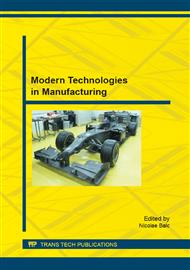[1]
Yu Haiqi, Wang Baofeng, Li Huiqin, Li Jianchao, - Influence of electromagnetic brake on flow field of liquid steel in the slab continuous casting mold, Journal of Materials Processing Technology 202, (2008), 179–187.
DOI: 10.1016/j.jmatprotec.2007.08.054
Google Scholar
[2]
Thomas, B.G., Yuan, Q., Sivaramakrishnan, S., Shi, T., Vanka, S.P., Assar, M.B., Comparison of four methods to evaluate fluid velocities in a continuous slab casting mold, ISIJ Int. 41 (10), (2001), 11262–1271.
DOI: 10.2355/isijinternational.41.1262
Google Scholar
[3]
Huang, X., Thomas, B.G., Najjar, F.M., Modeling superheat removal during continuous casting of steel slabs. Metall. Trans. B 23, (1992), 339–356.
DOI: 10.1007/bf02656290
Google Scholar
[4]
Luca A, Balc N, Popan A, Ceclan V, Panc N , Improving the quality of the parts made by rapid metal casting process. - Academic Journal of Manufacturing Engineering, Vol. 12 Issue 1, (2014), 82-86.
Google Scholar
[5]
Luca A, Balc N, Popan A, Panc N, The influence of investment casting process parameters of complex metal parts, Academic Journal of Manufacturing Engineering, Vol. 10, Issue 3, (2012), 57-62.
Google Scholar
[6]
Dănăilă S., Berbente C., Metode numerice în dinamica fluidelor, Editura Academiei Române, Bucureşti, (2003).
Google Scholar
[7]
Chattopadhyay H., Simulation of transport processes in squeeze casting. J Mater Process Tech 186, (2007), 174–178.
Google Scholar
[8]
Jaradat M., Transfer convectiv de masa, caldura si radiatie in fluide vascoase si prin medii poroase, Editura Dacia Cluj-Napoca, (2005).
Google Scholar
[9]
D. McBride, T.N. Croft, M. Cross, A coupled finite volume method for the computational modeling of mould filling in very complex geometries, Computers & Fluids No. 37 (2008), 170–180.
DOI: 10.1016/j.compfluid.2007.06.001
Google Scholar
[10]
Tudose L., Haragas S., Buiga O., Tudose C., Increasing injection molding speed through cooling system geometry optimization, Materiale Plastice, 51, (3), (2014), 252-257.
Google Scholar


